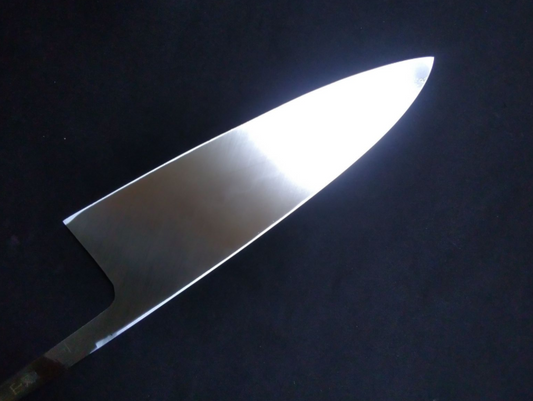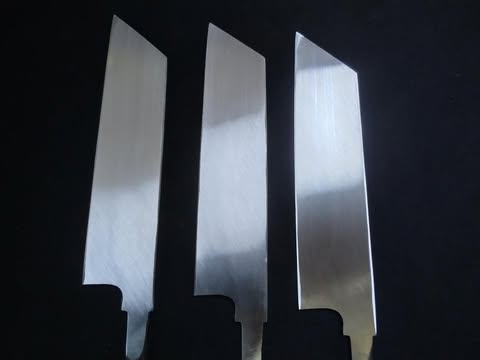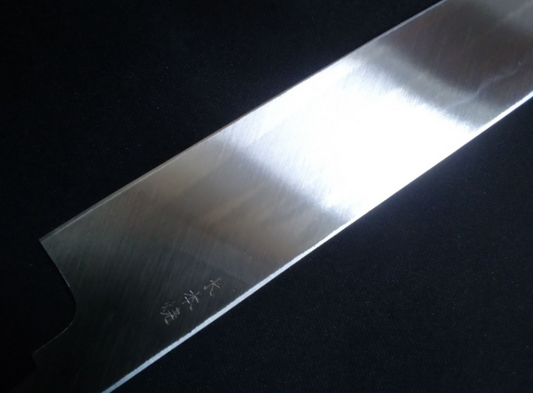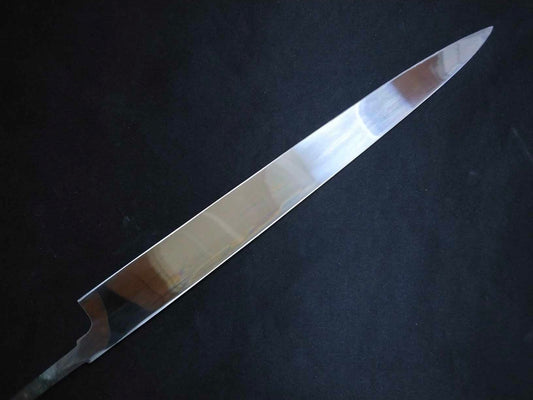
White Steel #2 (Honyaki-Mizuyaki)
-
A blade of absolute purity — born where skill meets courage.
Forged from White Steel #2, an ultra-pure carbon steel revered for its clarity and character.
Through the unforgiving mizuyaki water-quenching process, the glowing steel meets icy water in a single decisive moment — a test that only master artisans dare to face.
The result: a Honyaki knife that captures the very edge of Japanese craftsmanship, where beauty, precision, and spirit become one. -
White Steel #2 (Honyaki-Mizuyaki) Japanese Knife Collection
-
White Steel #2 (Honyaki-Mizuyaki) Deba 180mm-Mirror Polished(one side)
Regular price $750.00 CADRegular priceUnit price / per$0.00 CADSale price $750.00 CADSold out -
White Steel #2 (Honyaki-Mizuyaki) Yanagiba 210mm-Mirror Polished(one side)
Regular price $800.00 CADRegular priceUnit price / per$800.00 CADSale price $800.00 CAD -
White Steel #2 (Honyaki-Mizuyaki) Mukimono 180mm-Kido Finishing
Regular price $850.00 CADRegular priceUnit price / per$380.00 CADSale price $850.00 CADSold out -
White Steel #2 (Honyaki-Mizuyaki) Mukimono 180mm-Mirror Polished(one side)
Regular price $930.00 CADRegular priceUnit price / per$380.00 CADSale price $930.00 CAD -
White Steel #2 (Honyaki-Mizuyaki) Yanagiba (Sakimaru) 300mm-Mirror Polished(one side)
Regular price $1,000.00 CADRegular priceUnit price / per$0.00 CADSale price $1,000.00 CAD -
White Steel #2 (Honyaki-Mizuyaki) Yanagiba (Sakimaru) 360mm-Mirror Polished(one side)
Regular price $1,300.00 CADRegular priceUnit price / per -
White Steel #2 (Honyaki-Mizuyaki) Yanagiba 240mm-Mirror Polished(one side)
Regular price $1,400.00 CADRegular priceUnit price / per$1,200.00 CADSale price $1,400.00 CADSold out -
White Steel #2 (Honyaki-Mizuyaki) Yanagiba 300mm-Mirror Polished(one side)
Regular price $1,600.00 CADRegular priceUnit price / per$1,600.00 CADSale price $1,600.00 CADSold out -
White Steel #2 (Honyaki-Mizuyaki) Yanagiba 330mm-Mirror Polished(one side)
Regular price $1,900.00 CADRegular priceUnit price / per$1,900.00 CADSale price $1,900.00 CAD -
White Steel #2 (Honyaki-Mizuyaki) Yanagiba 360mm-Mirror Polished(both sides)
Regular price $1,950.00 CADRegular priceUnit price / per$380.00 CADSale price $1,950.00 CADSold out
KIREAJI's Three Promises to You
-

1. Forged in the Legacy of Sakai
From Sakai City—Japan’s renowned birthplace of professional kitchen knives—each blade is crafted by master artisans with over six centuries of tradition. Perfectly balanced, enduringly sharp, and exquisitely finished, every cut carries the soul of true craftsmanship.
-

2. Thoughtful Care for Everyday Use
Every knife includes a hand-fitted magnolia saya for safe storage. Upon request, we offer a complimentary Honbazuke final hand sharpening—giving you a precise, ready-to-use edge from day one.
-

3. A Partnership for a Lifetime
A KIREAJI knife is more than a tool—it is a lifelong companion. With our bespoke paid aftercare services, we preserve its edge and beauty, ensuring it remains as precise and dependable as the day it first met your hand.

Why Many Product Photos Show Only the Blade
At KIREAJI, every knife is made to order in Sakai, Japan. Photos show the blade before the handle is attached, allowing artisans to perfect the balance and edge for your specific order. Your knife arrives fully finished — tailored just for you.

Global Delivery from Sakai
Across the world, discerning cooks seek authentic Japanese knives from Sakai — Japan’s legendary knife-making city with over 600 years of tradition.
At KIREAJI, we work alongside master artisans in Sakai to fulfill that desire, shipping genuine handcrafted knives directly from the workshop to kitchens worldwide.
White Steel #2 (Honyaki-Mizuyaki) — For Those Who Seek the Purest Blade
-
This is not just a knife — it is a commitment.
A White Steel #2 Honyaki — water-quenched and forged from a single piece of ultra-pure carbon steel — is considered one of the most challenging blades to create in Japanese knifemaking. In the hands of a master, the result is a knife of exceptional sharpness, longevity, and precision.
-

What is White Steel #2?
White Steel #2 (Shirogami #2) is a high-purity carbon steel with almost no alloying elements.
Because it contains so few additives, it can take an extremely fine edge and is easier to sharpen compared to stainless or highly alloyed steels.
However, it is also less resistant to rust, which means regular maintenance is essential. -

Why Water Quenching Matters
The mizu-honyaki process involves heating the blade to the ideal temperature, then rapidly cooling it in water. This maximizes hardness and edge retention — but it’s risky. A slight misjudgment in temperature or timing can cause cracks or warping, which is why each successful blade is rare and highly valued
-

The Sharpening Experience
Sharpening a White Steel #2 Honyaki is a hands-on, skill-building experience:
- The steel responds well to whetstones, allowing you to feel progress clearly as the edge refines.
- Because it is hard and single-structure, every movement on the stone directly affects the cutting performance.
- Mistakes — such as using the wrong angle or too much force — can cause chipping, so steady, deliberate strokes are key.
- Using the correct whetstone grit for each stage ensures a keen, long-lasting edge.
-
How It Performs
In use, the blade offers:
- Effortless, precise cuts that preserve the natural texture and freshness of ingredients.
- Clean slices in fish, vegetables, and meat without crushing fibers.
- A level of control that makes it feel like an extension of your hand.
-

Who Should Choose This Knife
- Professional chefs or experienced home cooks seeking the highest level of cutting performance.
- Those who enjoy maintaining and sharpening their own knives.
- Cooks who value traditional Japanese craftsmanship and want a tool that will grow with their skills.
-
Who Should Consider Other Options
- Those who prefer low-maintenance knives.
- Beginners unfamiliar with carbon steel care.
- Users who need extra durability for heavy-duty or bone-cutting tasks.
-
White Steel #2. Water-quenched. Honyaki.
A knife for those who are ready to match the dedication of the craftsman who made it.
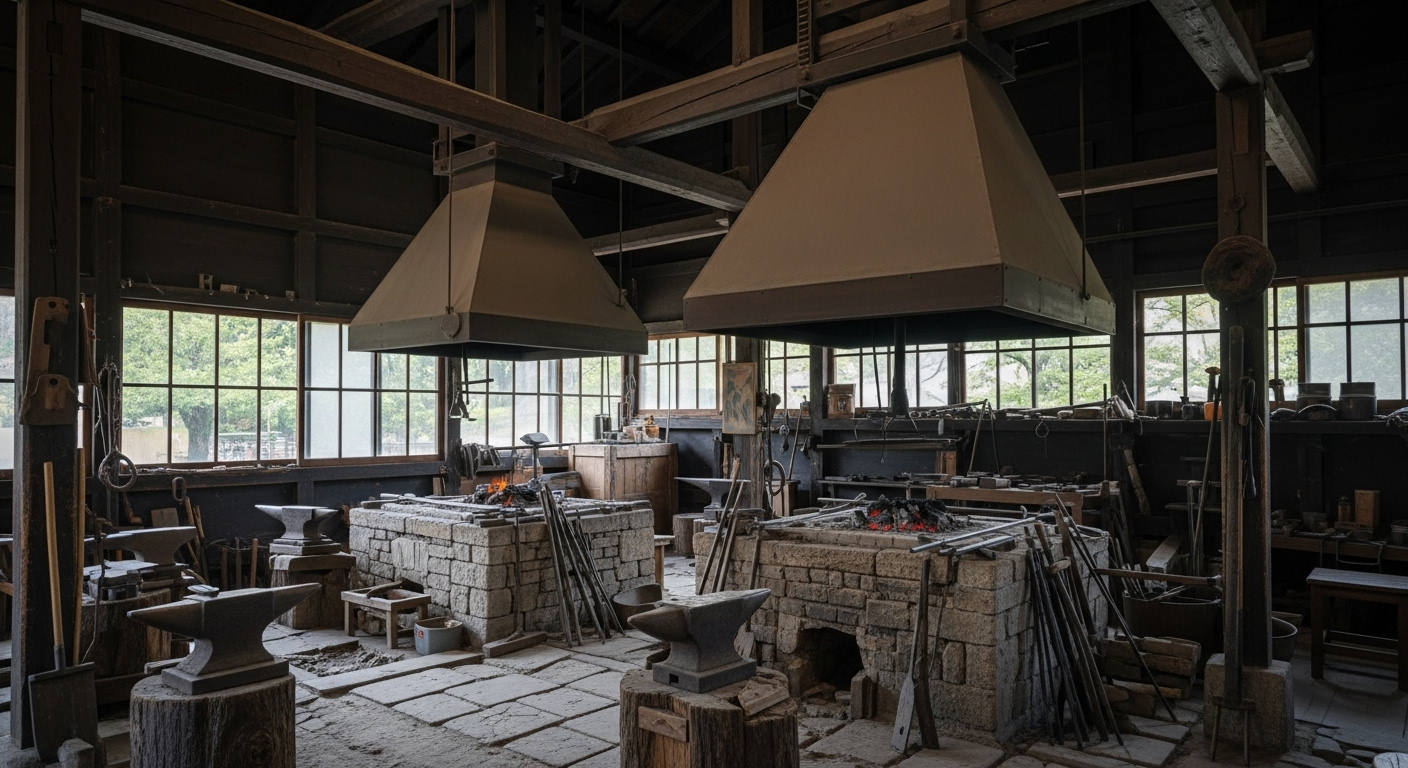
FAQ About White Steel #2 (Honyaki – Mizuyaki)
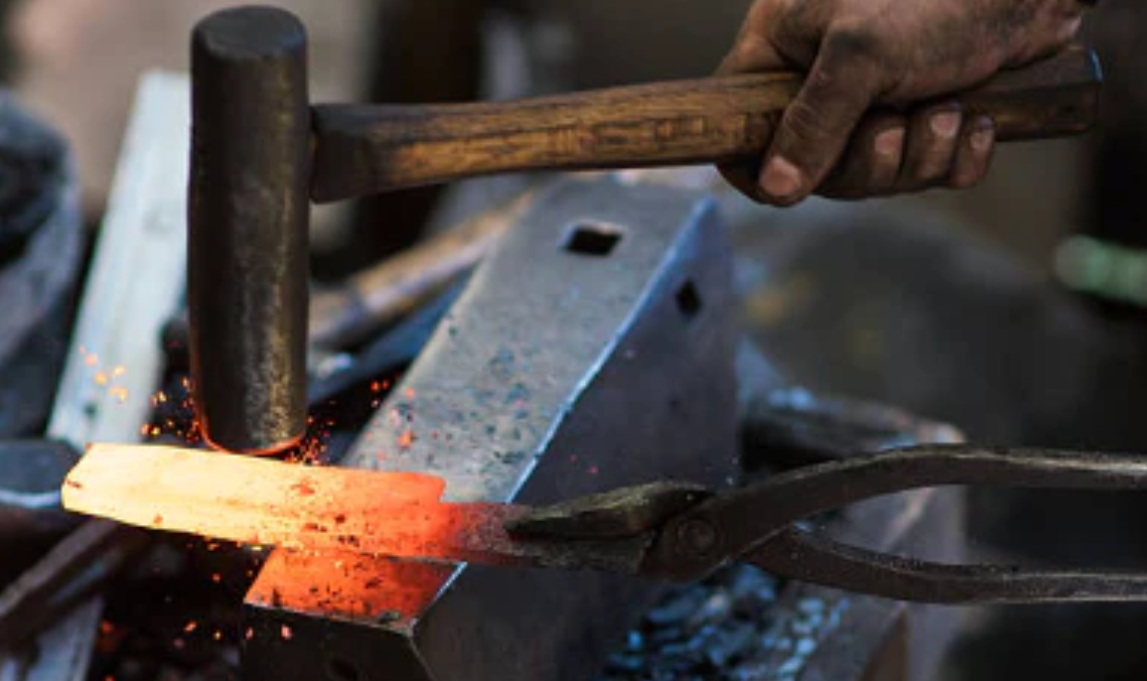
Q1. What is White Steel #2 (Mizuyaki)?
White Steel #2, or Shirogami No.2, is a high-purity carbon steel with almost no alloying elements. When hardened using the traditional Mizuyaki method—quenching in water—it reveals its full potential: extreme sharpness, clarity, and peak performance. This steel is most often used in Honyaki knives, forged from a single piece of steel. Such knives are not merely tools, but the pinnacle of Japanese craftsmanship, trusted by professionals who demand absolute precision.
Q2. Why are White Steel #2 (Mizuyaki) knives so expensive?
Because perfection allows no second chances. Mizuyaki quenching is a one-shot process—if the temperature, timing, or technique is even slightly off, the blade may warp, crack, or fail entirely. Add to this the immense time, concentration, and mastery required, and each finished knife becomes a rare work of functional art. The high price reflects not only the material but also the risk, craftsmanship, and spirit invested in every blade.
Q3. Are they easy or difficult to sharpen?
Both. White Steel #2 is uniform and highly responsive, which means it provides clear feedback during sharpening—an advantage for skilled users. The burr (kaeri) forms cleanly, making it easy to “read” the steel. However, the extreme hardness of Honyaki blades also makes them physically demanding to sharpen. Even small mistakes—too much pressure, the wrong angle, or overheating—can cause chips or irreversible damage. Selecting the right whetstone is essential, as too soft or too hard a stone may compromise the process. A White Steel #2 Honyaki knife rewards patience and precision, teaching the user discipline with every sharpening.
Q4. Is White Steel #2 prone to rust?
Yes. Being pure carbon steel, it reacts quickly to moisture, acidity, and even the air. To prevent rust, wash and dry the knife thoroughly after each use, apply a light coating of camellia oil or similar rust-preventive oil, and store it in a dry, well-ventilated space. With proper care, the blade will not only resist corrosion but also develop a beautiful patina over time, aging gracefully as it serves for decades.
Q5. What are the key benefits of White Steel #2 (Mizuyaki)?
White Steel #2 offers uncompromising sharpness when properly maintained, delivering surgically clean cuts ideal for sashimi, kaiseki, and other delicate preparations. It also provides a highly responsive sharpening experience for those who enjoy the craft. Over time, the knife evolves with the user, gaining character and depth—a mirror of both skill and mindset. It is more than a tool; it is a lifelong companion in the kitchen.
Q6. Who should choose White Steel #2 (Mizuyaki)?
This knife is best suited for experienced chefs, professional users, and enthusiasts who are deeply committed to Japanese craftsmanship. Its hardness, responsiveness, and demand for careful maintenance make it less practical for beginners. But for those willing to learn and care for it properly, White Steel #2 (Mizuyaki) offers not just unmatched performance, but also the profound satisfaction of owning one of the purest expressions of Japanese knife-making tradition.

The Current State of Honyaki Knives
Honyaki knives, forged one by one by master blacksmiths, are among the most prized and expensive Japanese blades. As global interest in fine cooking grows, these knives are drawing increasing attention from enthusiasts seeking authentic Japanese cuisine and precision in every cut.
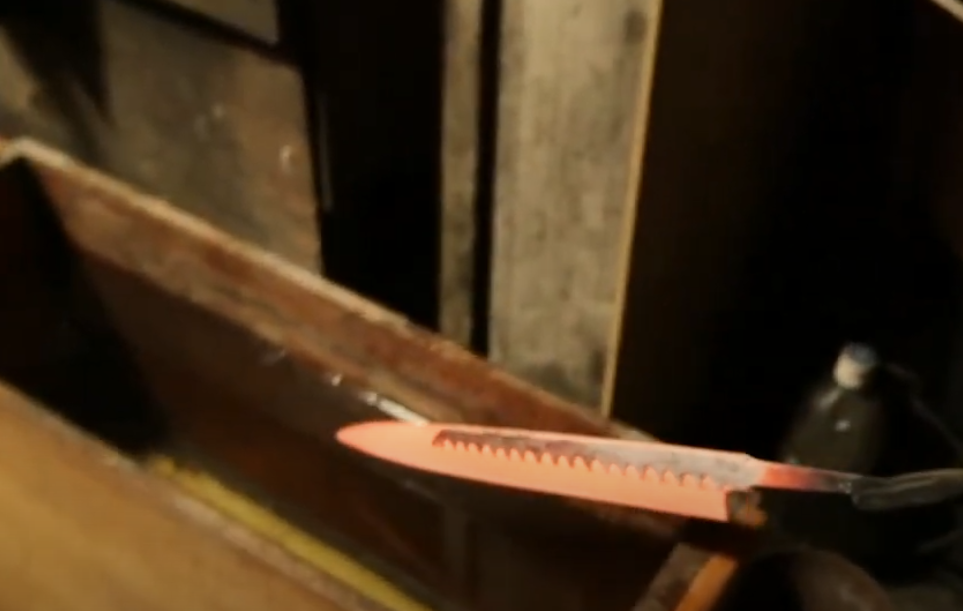
Mizuyaki vs Aburayaki
At the core of every Honyaki knife is a choice: Mizuyaki or Aburayaki. These two methods shape the blade’s character, performance, and beauty in distinct ways. Explore the world of true craftsmanship and see what sets them apart.

Japanese Knife Materials
The steel behind a Japanese knife defines its sharpness, durability, and care. From traditional carbon steels like White #2 and Blue #2 to modern innovations such as Ginsan and ZDP189, each material offers its own balance of performance and maintenance. This guide explores how these choices shape the knives we use today.
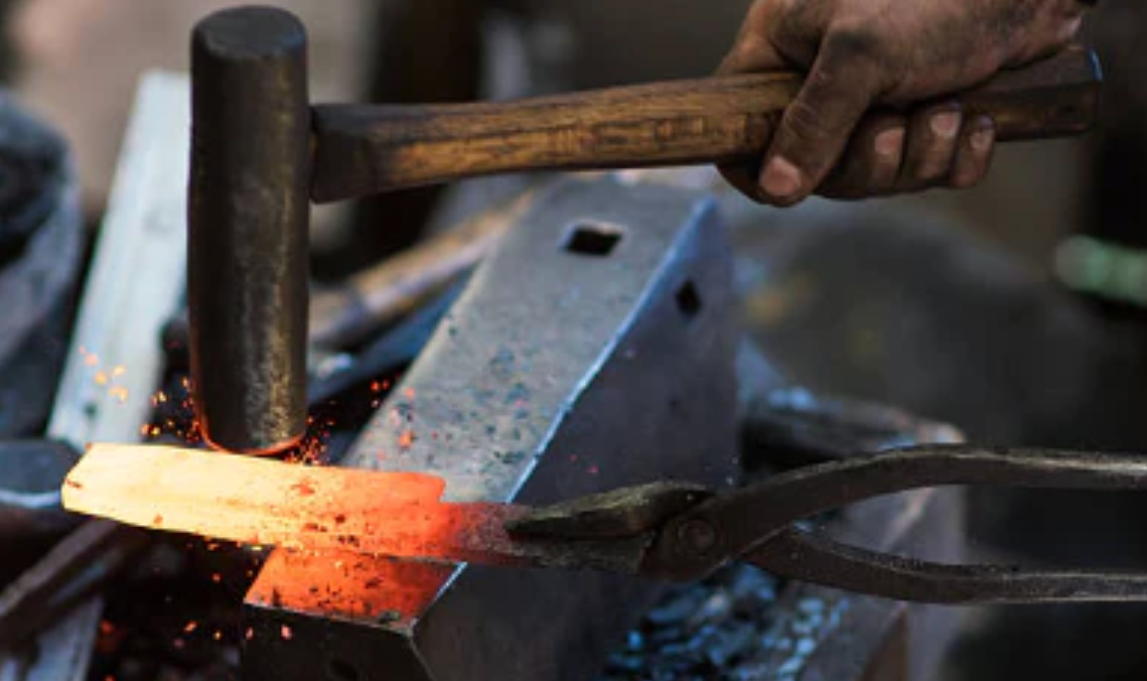
The Soul of Craftsmanship
-
Quiet Passion Forged in Steel — My Belief in White Steel #2 (Mizuyaki)
A good blade doesn’t need to speak. It speaks through use.
People are often puzzled when I say this.
But for us craftsmen, White Steel #2 (Mizuyaki) is steel that speaks without words. Made only of iron and carbon, it is deceptively simple. No alloys to hide behind, no shortcuts to take. Its purity makes it delicate—and in that delicacy lies extraordinary sharpness.Mizuyaki, or water quenching, is a traditional heat treatment. The steel is heated to perfection and plunged into water in a single decisive moment. Get it right, and the blade sings a clean, quiet note. Get it wrong, and it cracks. Still, we do it—because when it works, the steel comes alive.
-
Chefs often tell me:
“This knife doesn’t cut—it pulls the food in.”
That sensation is no accident. It comes from the purity of the steel, the precision of the quench, and the rhythm of the sharpener’s hands in harmony.Of course, it is not an easy knife to care for. It rusts easily. It chips. It can be temperamental. But for those who care for it, it gives back like no other.
-
Sometimes, while sharpening, I feel a faint burr—the kaeri—brush against my fingertip.
“Ah, I got it today,” I think. That is how I know: the steel is speaking back.Our work as craftsmen is not only to make knives. It is to build a bridge between the chef and the blade, so that the steel may speak—and be heard.
White Steel #2, quenched in water, carries everything needed for that conversation. That is why I believe in it. That is why I continue to forge it.
A single knife can change a life
-
Forged entirely by hand in Sakai, Japan, this blade carries the legacy of traditional Japanese sword-making, elevated by generations of craftsmanship, discipline, and pride.
With its unmatched sharpness, breathtaking beauty, and the spirit of absolute dedication, the Honyaki is more than a tool — it is the soul of the chef, a lifelong partner in the pursuit of mastery, trusted by professionals around the world. -


